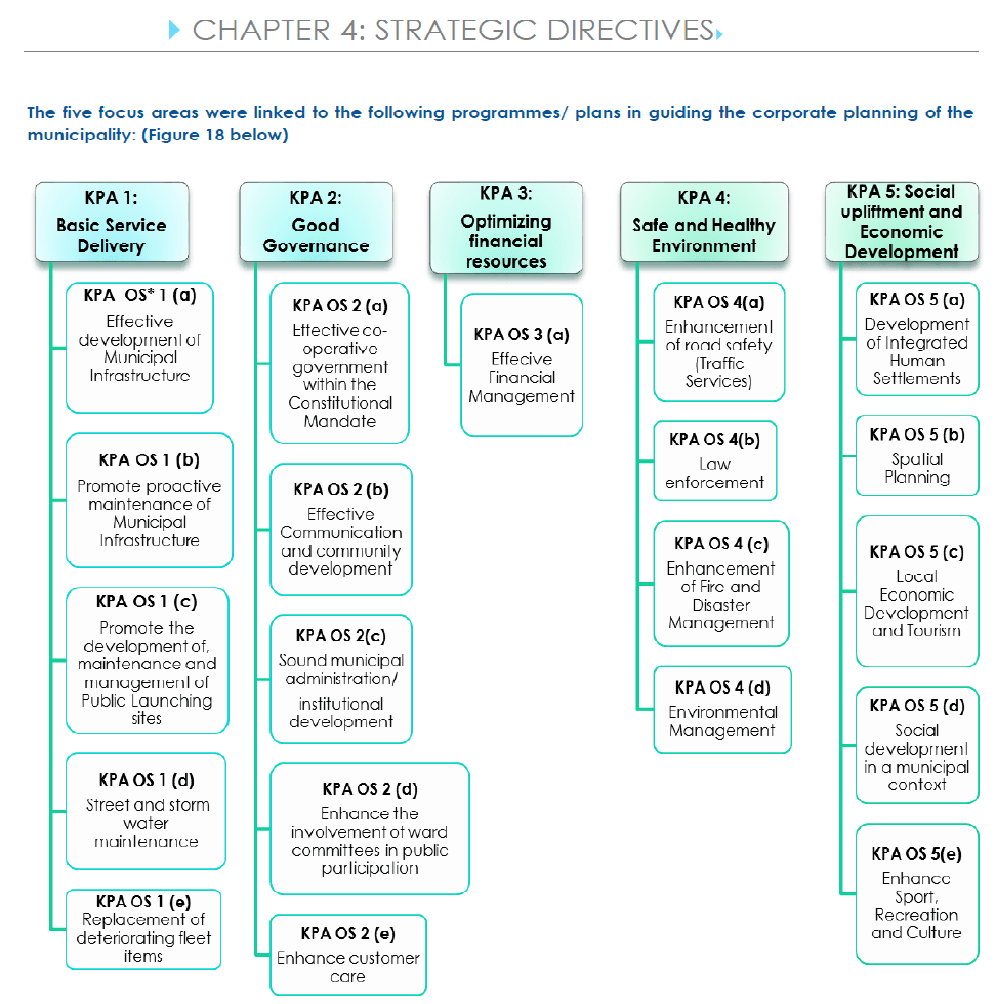Overstrand Municipality tabled a draft 2025 version of their Integrated Development Plan (IDP). It is understood that this is a 5-year plan, and the first version was drafted in 2022. The plan being annually updated through introducing revisions as necessary.
This document provides that the comments of Hermanus Ratepayers Association (HRA) on the draft for the 25/26 financial year.
Download and read this article as PDF
Overstrand Municipality tabled a draft 2025 version of their Integrated Development Plan (IDP). It is understood that this is a 5-year plan, and the first version was drafted in 2022. The plan being annually updated through introducing revisions as necessary.
This document provides that the comments of Hermanus Ratepayers Association (HRA) on the draft for the 25/26 financial year.
Prior to commenting on the detail, it is prudent to confirm and reflect on the fundamentals of the IDP, the context in which it is developed as a point of departure.
What is the purpose of the IDP in South Africa?
The Integrated Development Plan (IDP) in South Africa serves as a strategic framework for local government planning and development, aiming to improve the quality of life for all residents.
It outlines strategies for managing municipal finances and facilitates essential service provision, infrastructural development, and disaster management. IDPs also aim to coordinate the work of local and other spheres of government in a cohesive manner.
………………………………………………………………………………………………………………………………….
But before we detail our feedback, a general comment:
We find the process somewhat repetitive with relatively few updates during the 5-year cycle. However, Overstrand, like other areas in the Western Cape, are experiencing substantial growth and changes to the demographics. It is essential to regularly revisit the vision and plans. The current approach to deal with this planning later in the budget cycle is not optimal. We propose that a strategic planning session be held much earlier, say in in the 3rd term of the previous year (e.g. August 2025). It is also important that each year’s IDP session thoroughly covers a term of at least 5 years ahead.
…….. and another important point. Adding different views to the process
There are residents with superb strategic planning skills in Overstrand, and we propose that a few of them be invited to participate in such planning session as proposed above. Maybe also good to add additional perspective by including a representative of the IDP design team for the City of Cape Town. We feel it is essential to increase the link between Cape Town and Overstrand.
…….. and Hermanus into the future?
The IDP is based on a 5-year outlook. However, to properly achieve that, it would be wise to apply a longer horizon to some of the aspects. Just imagine what Overstrand will look like in 2040?
As invested Hermanus ratepayers, we are convinced that this approach with yield a more comprehensive strategy and will allow for more inclusivity. This will bring a fresh new approach to the process and will be much more effective than just capturing some comments many months later.
……………………………………………………………………………………………………………………………………
Back to our comments on the proposed 2025 IDP
CHAPTER 2: STRATEGIC ANALYSIS
It is noted that the 5 Strategic Objectives are retained. We want to highlight 2 of the 5 strategic objectives
In this instance we feel that OSM must draw much more on the skill pool available amongst the ratepayers. This can be coordinated via organisations such as HRA.
Both are very important but require more attention. Well qualified staff must be allocated to very important portfolios such as tourism en local economic development.
There was also the idea of the previous mayor’s 3 C strategic interventions. This may need revisiting for the future.
We agree with the 11 risk factors. However, these should be prioritised on an annual basis.
Zwelihle (wards 5, 6 and 12) in Hermanus has the largest population totalling 29 997 residents. Compared to Hermanus ward 3 of only 7030 residents. (All according to Census 2022).
Important to note the growth trend differences between Ward 3 of Hermanus compared to that for Wards 5,6,8 and 12.
Extensive effort in LED is required to respond to the ever-increasing employment demands due to the projected growth in latter wards.
As per the definition, the Upper Bound Poverty Line (UBPL) applies to the population that cannot afford to purchase adequate levels of food and non-food items. This is an individual living with less than R1 684 (in April 2024 terms) per month.
In 2023, 74 % of the OSM’s population fell below the UBPL. This figure has not improved from its 2020 level. This represented the highest proportion within the district poverty levels and is a point of concern.
We include the full item list for Ward 3. This will provide the reader an idea of which items had been prioritised. However, not all had been included in the actual 25/26 budget.

CHAPTER 3: SITUATIONAL ANALYSIS PER NATIONAL KPA’S
Top management Team structure must be reviewed. There is an Imbalance if compared to the actual needs. Refer to Chapter 5 below, which sets out the current directorates.
CHAPTER 4: STRATEGIC DIRECTIVES
This is the most comprehensive section and is by far the best updated for 2025/2026. It covers, in quite good detail, the 5 Key Areas that are guiding the planning of OM. However, through scrutinising theses KPAs, it is also possible to track where OM is understaffed, e.g. in Local Economic Development (LED) and Environmental Management Services (EMS). It would be good if OM can inform the ratepayers, on a regular basis, about their progress on these programmes and plans.

CHAPTER 5: FUNCTIONAL AREAS OF MUNICIPAL ACTIVITIES
This chapter is introduced as follows:
The following is an analysis of the respective functional areas of the Municipality in relation to the main priorities, constraints faced and functional strategies. The functional areas are grouped under relevant strategic priority/objective as set out in the vison and mission statement.
In comparison to Chapter 4, this section is not well developed and lack detail.
A point of concern is that there are several important positions that have remained vacant for quite a while. It’s essential that these be filled without delay to ensure proper functioning of the relevant directorates. An example is:
Strategic objective 5: Promotion of tourism, economic and social development
These are very important sectors but are unfortunately totally understaffed in OM. It needs urgent attention and a fresh focus to ensure that this objective will be met successfully.
CHAPTER 6: SERVICE LEVEL AGREEMENTS
It is advised that OM share their service delivery commitments and agreements with the ratepayers more regularly via various media platforms.
A more specific item:
Tanker Services for sewage disposal
The lack of water borne sewage disposal results in unnecessary financial and environment impacts for the residents. It is proposed that the planning and budgeting for elimination of this practice be given much higher priority.
Nothing noted about this item under OMs service level agreements in this IDP?
CHAPTER 7: GOVERNMENT POLICIES AND DIRECTICE
Sustainable Development Goals: Promote sustained, inclusive and sustainable economic growth, full and productive employment and decent work for all
OSM response is as follows:
– Creation of an environment conducive for LED.
– Implement a contractor development programme
– Promote and support entrepreneurship and innovation.
– Capacity development programmes, mentoring and linkages to grow and develop business skills.
– Promote Investment in high production sectors.
– Implement the PPPFA regulations.
– Commit to the process of Red Tape reduction for the ease of doing business.
– Operating a walk-in centre to access information.
– Implement- Cost and Ease of doing business principles
In conclusion, the above are all good initiatives, but some (Highlighted), need more support from OM
CHAPTER 8: OVERSTRAND SERVICE ORIENTED SECTOR PLANS – HIGH LEVEL SUMMARIES
Not much about the Strategic Environmental Management Framework. The pristine environmental elements in the Overstrand Region are major fundamental assets for OSM and require more focus and attention in this document. The Protected Area Management Plan (PAMP) for the Fernkloof Nature Reserve (FNR) was completed in 2024, but is unfortunately still a very broad document lacking specifics and like many of these plans, it is not user-friendly.
CHAPTER 9: LOCAL ECONOMIC DEVELOPMENT
A definition that indicates the importance of LED.
Local Government as the closest sphere to the people has a constitutional mandate to undertake a developmental approach when implementing policies. Therefore, through LED local government can meet the basic needs of the people by establishing an environment (whether directly or indirectly) that will create jobs and alleviate poverty in a sustainable manner. Maximum economic growth can be achieved by streamlining LED throughout the municipal efforts in service delivery.
This current LED chapter is comprehensive and contains many parts. However, it will require a skilful team to coordinate and manage its implementation successfully. We contend that the current structure does not provide the required capacity to give effect to the intent. It is essential that OM give prominence to this portfolio and appoint staff that can lead and coordinate sustainable LED for the region.
CHAPTER 10: REVIEWED MUNICIPAL SPATIAL DEVELOPMENT FRAMEWORK (MSDF)
The current MSDF was adopted in 2020 and requires an update. It is noted that a service provider was appointed for the amendment of this MSDF and that the amendment will be subject to public participation. The aim is to have the project complete in the 2025/26 financial year. Who is the consultant and what is the terms of refence for the appointment?
The MSDF is an extensive and important part of the municipal planning process and needs separate attention. The MTEF also requires upgrading.
